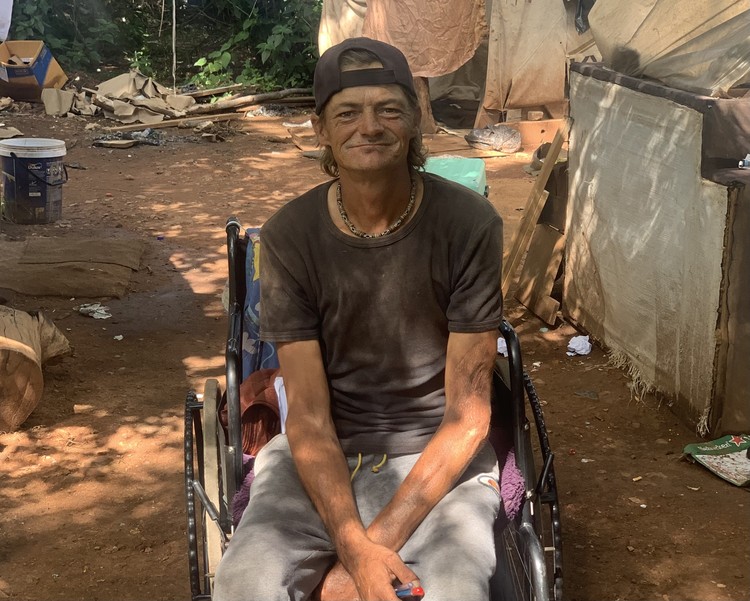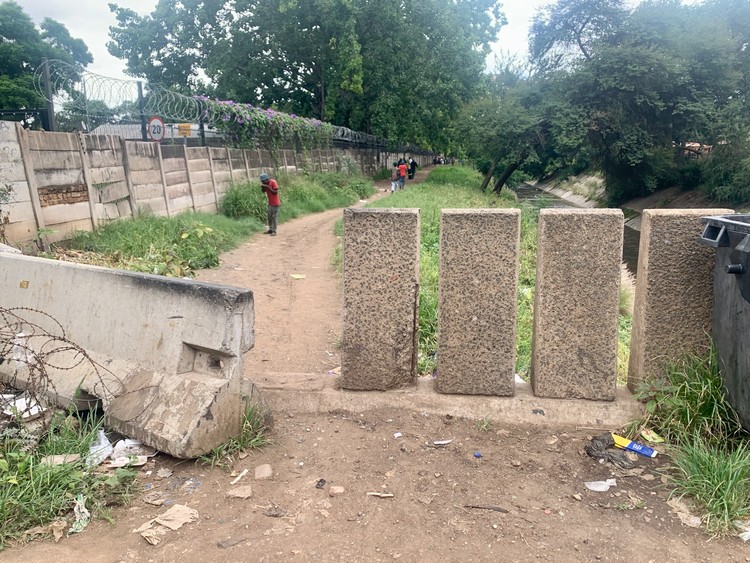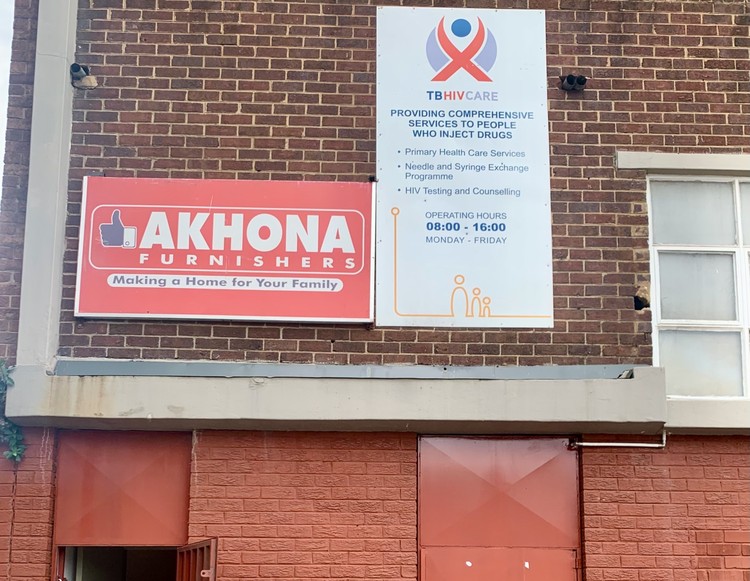HIV patients go weeks without medicines after US aid cut
Legal challenges have restored funding but damage has been done
Christoffel de Jongh in the tented community where he lives in central Pretoria. He relies on a US-funded health facility for his HIV medicines as well as methadone. Photos: Jesse Copelyn
- A US-funded health facility in Pretoria shut its doors for over two weeks after an executive order by President Trump paused funding.
- A beneficiary of the centre, who is HIV-positive, said that he hadn’t taken his ARVs in roughly two weeks due to the closure. Many were in the same predicament.
- The health centre reopened on 13 February after funding resumed.
On 5 February Rethabile Seshabela went to her local health centre to fetch her antiretroviral medicines (ARVs). She found the doors were shut. There was a sign saying the centre was temporarily closed.
The centre in central Pretoria is run by TB HIV Care, a health organisation, and funded by the US President’s Emergency Plan for AIDS Relief (PEPFAR). But like other US-funded organisations around the world, the centre was forced to halt services in late-January. This came after an executive order by the Trump administration paused all foreign development funding for 90 days, pending a review.
Legal challenges in the US have since restored funding for the centre, which reopened on Thursday. But damage has been done by the interruption of services.
“A lot of them were defaulting”
Near the centre is a dirt path that runs along the bank of the Apies river. Three drug dealers guard the entrance. Beyond them, a group of roughly 70 homeless people crowd around, smoking and injecting drugs like heroin, crack and crystal meth. This small strip of riverbank is known locally as 16 Passage. It’s a place filled with beneficiaries of the TB HIV Care centre.
In Tshwane over 70% of all people who inject drugs are HIV-positive, partly because needles get shared when people don’t have access to new ones. It’s for this reason that the centre focuses on substance users – people likely to contract and spread the virus. The centre offers ARVs, HIV testing and PrEP. It also provides clean needles in order to prevent people from sharing. This is a proven method of reducing HIV transmission.
When the facility was closed without warning, many people were cut off from these medical services.
One man in 16 Passage — we’ll call him Sipho — said he didn’t know where else to get his ARVs. He tried a government facility, but they asked for a referral letter from his previous provider. Since he didn’t have this he gave up and went home.
Ordinarily, the TB HIV Care centre should have been able to provide the referral, which would simply verify that the man was HIV-positive and needed to continue his ARV treatment. However, US stop-work orders required staff to cease working immediately, so these letters weren’t issued.
Without a referral, patients needed to open up a file at the clinic and get their blood taken to check their CD4 count. Depending on the facility, this could involve a long wait time. Delays and complications could be made worse if the patient was homeless and didn’t have proof of residence or an ID.
Since people who use heroin can experience withdrawal within a few hours of their last shot, many are unable to bear through these long queues. In addition, homeless people who use drugs often face stigma in general healthcare settings, making many reluctant to go there.
Sipho told GroundUp and Spotlight that since the centre closed, he hadn’t taken his ARVs in roughly two weeks (the conversation took place before people were aware that the centre had reopened). This could come with risks. Viral rebound — which is when the virus replicates significantly, making a person more infectious — can occur within two weeks of a patient stopping their medication.
A second man in 16 Passage said that there were many others in the area with similar stories. “A lot of them were defaulting,” he says. He began listing people in the area before eventually giving up. “There’s no point in counting”.
The pathway to 16 Passage, along the bank of the Apies river. It’s a place filled with beneficiaries of the TB HIV Care centre.
Following service disruptions, needles shared
Perhaps worse still was the temporary closure of TB HIV Care’s needle and syringe program. One man in 16 Passage explained that when he couldn’t get clean needles from the centre, he resorted to sharing with someone else out of desperation. Later on he began to worry, as he didn’t know the HIV status of that person. The last time he had been tested he was HIV-negative. He worried that this may no longer be the case.
Similar stories were repeated by many others in the area: as needles became more scarce, people either reused needles (which damages the skin and veins), shared them, or picked them up off the floor. The risks of sharing would have been compounded by the lack of ARVs in the area. If people go off their medication, their viral load increases, making them more infectious.
Other key services were also impacted. A couple of kilometres away from 16 Passage, a TB HIV Care patient, Christophel De Jongh, explained that he’d been using heroin since 2005, but that TB HIV Care’s methadone program had been helping him to reduce his intake. Methadone blocks withdrawal in people who are stopping heroin or cutting down. He worried that the closure of the program could derail the progress he had already made.
“If we have to leave methadone it’s going to be a bugger up,” he told Spotlight and GroundUp from the tented encampment where he lives. “You can’t just stop.” Without the treatment, people would simply go back to using more heroin in order to stave off withdrawal symptoms, he says. He believed that an uptick in crime would follow.
Aside from methadone, De Jongh also got ARVs from the centre. The fact that he could pick up both sets of treatment in one place made life easier for him since he is in a wheelchair. He was concerned that he may now have to get his ARVs and methadone at separate places, if he could get them at all.
Funding resumes, but some costs have already been borne
The US primarily distributes PEPFAR funds through two agencies. The one is USAID. The second is the Centres for Disease Control and Prevention (CDC), which is where TB HIV Care gets its PEPFAR funds from.
Last week, the CDC sent a letter out to all beneficiary organisations rescinding the stoppage, allowing its beneficiaries to once again draw down funds. (USAID did not send out the same notification; many of its recipient organisations remain closed.) The CDC notification told recipients that this was in line with a temporary restraining order issued by a federal judge in Rhode Island. That order blocked the Trump administration from freezing congressional appropriations.
GroundUp and Spotlight visited the TB HIV Care centre on 13 February, the day it reopened. The two-week disruption to HIV prevention services, like needle programs, may very well have led to people contracting infectious diseases in the interim.
Still, things could have been worse. On Thursday, many people in 16 Passage weren’t yet aware that the centre had reopened that morning. This includes the person who said that he hadn’t taken his ARVs in two weeks. After Seshabela informed him, he soon walked in the direction of the centre. Had legal challenges to Trump’s executive order failed, it’s unclear what would have happened to this man.
This TB HIV Care building in central Pretoria was shut for over two weeks. Photos: Jesse Copelyn.
Field work for this article was made possible by Rethabile Seshabela and Barend Beukes. Seshabela chairs the South African National AIDS Council’s subsector on people who use drugs within Tshwane. Beukes is deputy chair. Each spent hours taking GroundUp and Spotlight to places that would have otherwise been inaccessible.
Support independent journalism
Donate using Payfast

Don't miss out on the latest news
We respect your privacy, and promise we won't spam you.
Next: Cape Town museum tells story of life in Palestine
Previous: First day of lectures disrupted as UCT students protest
© 2025 GroundUp. This article is licensed under a Creative Commons Attribution-NoDerivatives 4.0 International License.
You may republish this article, so long as you credit the authors and GroundUp, and do not change the text. Please include a link back to the original article.
We put an invisible pixel in the article so that we can count traffic to republishers. All analytics tools are solely on our servers. We do not give our logs to any third party. Logs are deleted after two weeks. We do not use any IP address identifying information except to count regional traffic. We are solely interested in counting hits, not tracking users. If you republish, please do not delete the invisible pixel.



